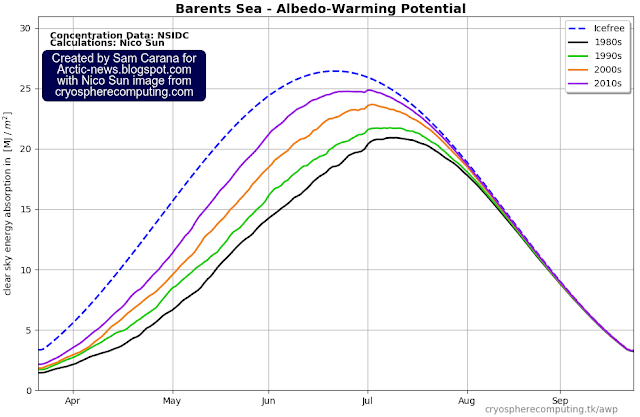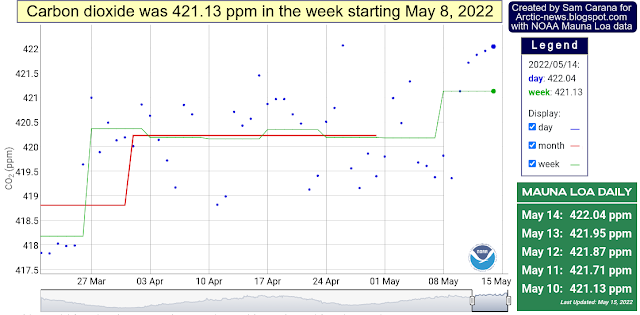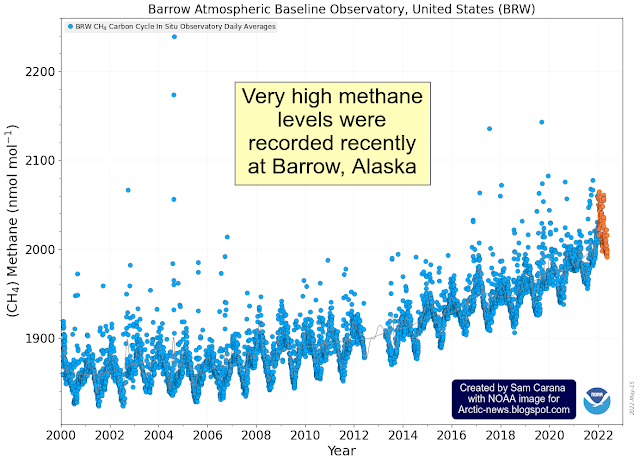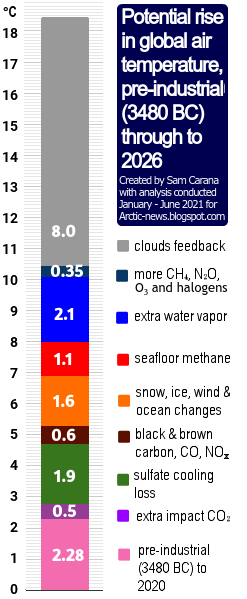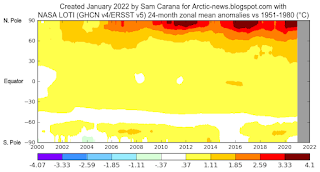The image shows that there is a lot of open water between the coast of Alaska and the sea ice.
Such a satellite image provides a visual way to determine how much sea ice is present. It can be hard to determine where there is open water and where the sea ice starts; the sea ice is often covered by clouds; furthermore, even when there are no clouds, the question remains what is to be regarded as sea ice and what is to be regarded as water.
The roughly-sketched outline drawn over the NASA map below indicates that there may only have been some 991 thousand km² of concentrated sea ice left on September 6, 2022 (inset shows NSIDC sea ice concentration for the day).
In conclusion, depending on what is counted as sea ice, we could already be experiencing a Blue Ocean Event right now.
- a strong El Niño triggers:
- further decline of the Arctic sea ice, with loss of the latent heat buffer, combined with
- associated loss of sea ice albedo and
- destabilization of seafloor methane hydrates, causing eruption of vast amounts of methane that further speed up Arctic warming and cause
- rapid thawing of terrestrial permafrost, resulting in even more emissions,
- while the Jet Stream gets even more deformed, resulting in more extreme weather events
- causing forest fires, at first in Siberia and Canada and
- eventually also in the peat fields and tropical rain forests of the Amazon, in Africa and South-east Asia, resulting in
- decline of snow and ice on mountains, at first causing huge flooding, followed by
- drought, heatwaves and urban collapse,
- collapse of the Greenland and West-Antarctic ice sheets,
- falling away of aerosol masking as civilization grinds to a halt,
- further heating due to gases and particulates from wood and waste burning and biomass decomposition, and
- further heating due to additional gases (including water vapor), cirrus clouds, albedo changes and heat rising up from oceans.
Here is another example of such a scenario. Recent studies indicate that human-caused climate change will soon increase El Niño frequency and intensity. Accordingly, the upcoming El Niño may well be strong. As illustrated with above image, we're currently in the depth of a persistent La Niña, which suppresses the temperature rise, whereas the opposite occurs during El Niño, which amplifies the temperature rise, and this especially affects the Arctic, which is already heating up much faster than the rest of the world. Also, the upcoming El Niño may very well coincide with a peak in sunspots in 2025, further pushing up temperatures.
A huge amount of heat has built up in the North Atlantic off the coast of North America, as illustrated by the image on the right.
Furthermore, the temperature of the water may well be substantially higher some 50 meter below the sea surface than at the sea surface.
NOAA's globally averaged marine surface mean for April 2022 was 1909.9 ppb. The above image shows that, on September 4, 2022 am, the MetOp satellite recorded a mean methane concentration of 1904 ppb at 586 mb, which is close to sea level. At 293 mb, however, the MetOp satellite recorded a mean of 1977 ppb, while at 218 mb it recorded a peak of 2805 ppb.
Such high methane levels could be caused by destabilization of methane hydrates at the seafloor of the Arctic Ocean, with large amounts of methane erupting (increasing 160 x in volume) and rising up at accelerating speed through the water column (since methane is lighter than water), concentrated in the form of plumes, which makes that less methane gets broken down in the water by microbes and in the air by hydroxyl, of which there is very little in the Arctic in the first place. Such a methane eruption entering the atmosphere in the form of a plume can be hard to detect as long as it still doesn't cover enough of the 12 km in diameter footprint to give a pixel the color associated with high methane levels.
Cutting-edge models predict that El Niño frequency will increase within 2 decades because of climate change, regardless of emissions mitigation efforts.
• NOAA - ENSO: Recent Evolution, Current Status and Predictions
https://www.cpc.ncep.noaa.gov/products/analysis_monitoring/lanina/enso_evolution-status-fcsts-web.pdf
• WMO predicts first “triple-dip” La Niña of the century
• Arctic sea ice August 2022
• Albedo
https://arctic-news.blogspot.com/p/albedo.html
• Latent Heat
https://arctic-news.blogspot.com/p/latent-heat.html
• Albedo, latent heat, insolation and more
https://arctic-news.blogspot.com/p/albedo.html
• Jet Stream
https://arctic-news.blogspot.com/p/jet-stream.html
• Feedbacks
https://arctic-news.blogspot.com/p/feedbacks.html
• Blue Ocean Event
https://arctic-news.blogspot.com/p/blue-ocean-event.html
• Climate Plan
https://arctic-news.blogspot.com/p/climateplan.html


